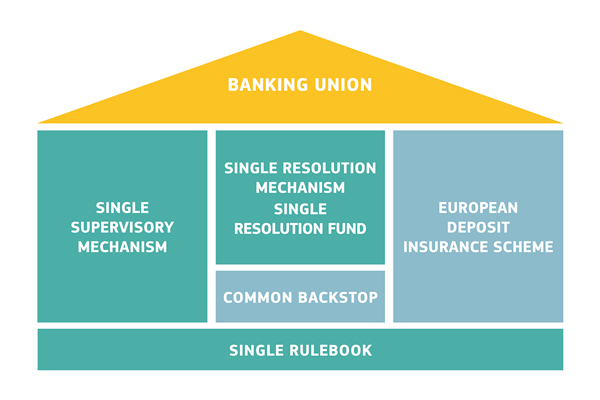Banking union

Related topics
Banking uniondate: 26/02/2021
Following the 2008-2009 financial crisis, the European Union put in place robust rules to address possible future bank failures, while improving depositor protection. But while banks entered the current crisis in relatively good shape, thanks in part to these reforms, the experience so far with the application of the current crisis management and deposit insurance (CMDI) framework indicates that adjustments may be warranted. Therefore, the European Commission is carrying out a review of the EU’s CMDI framework. The objective is to make the rules more effective, proportionate and consistent, while ensuring that taxpayers are protected and financial stability is preserved.
Post-crisis reforms
The regulatory reforms that followed the global financial crisis led to the creation of the banking union. This gave the euro area a single supervisory mechanism and a single resolution mechanism, and also created a single rulebook for the entire EU. More recently, euro area Member States agreed on an additional safety net, consisting of the common backstop to the single resolution fund to be provided by the European Stability Mechanism. This will add to the firepower of the resolution fund, which is financed by the banking sector. Discussions on a public sector backstop mechanism for providing liquidity in resolution are ongoing. The third element of the banking union, a European deposit insurance scheme (EDIS), is still missing.
The EU’s CMDI framework focuses primarily on the legislation covering bank resolution – the so-called ‘second pillar’ of the banking union – but also touches on deposit insurance (EDIS). It lays out the rules for handling bank failures, while preserving financial stability, protecting depositors and avoiding the risk of excessive use of public financial resources. The framework consists of three EU legislative texts: the Bank Recovery and Resolution Directive, the Single Resolution Mechanism Regulation), and the Deposit Guarantee Schemes Directive. These act together with relevant national legislation.
The overall purpose of the current review is to further strengthen the EU’s rules covering bank resolution. More specifically, the review aims to:
• assess how the current crisis management and depositor insurance framework works
• find ways to make the framework more proportionate, efficient and consistent in handling the resolution or liquidation of any bank in the EU, including by securing appropriate funding (internal and external)
• improve the synergies between crisis management and depositor protection, including by taking steps to complete the banking union.
Based on the outcome of the review, the Commission will bring forward an amending proposal towards the end of 2021.
Join us and #EUHaveYourSay
Gathering stakeholders’ experiences and exchanging views is of crucial importance when reviewing a legal framework. To this end, the Commission is organising a high-level conference, bringing together stakeholders from public authorities, industry and consumers. The conference is an opportunity to discuss the key issues and debate possible policy solutions. Commissioner Mairead McGuinness, Portugal’s Minister of State for Finance João Leão, ECB Vice-President Luis de Guindos, SRB Chair Elke König, Chair of the EP’s ECON Committee Irene Tinagli and many others will be taking part.
The Commission has also launched two consultations. A long, targeted consultation covers the general objectives and focus of the review, while also seeking feedback on more specific and technical aspects of the CMDI framework, as well as the need for changes in the future framework. A shorter, public consultation contains more general questions and is aimed at the general public. The results of these consultations will feed into the Commission’s work and the proposal it will be putting forth later this year.
Read more on the banking union
Take part in the targeted consultation or the public consultation

